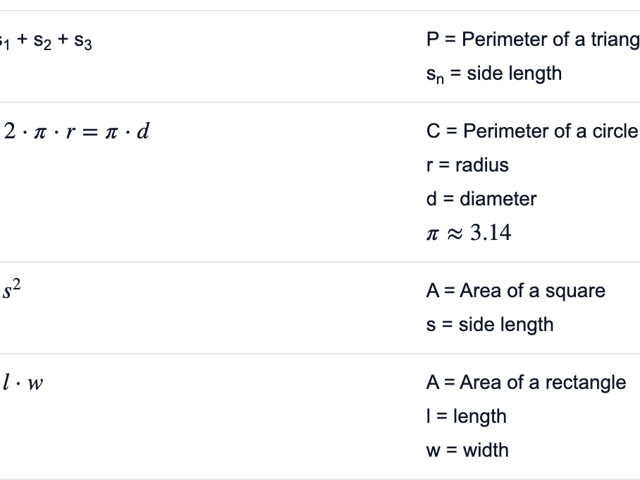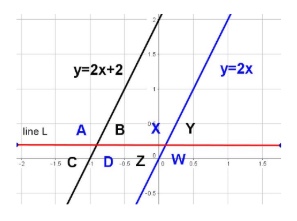
Formula Chart for the TEAS Mathematics and Science Tests
“Math and Science Aren’t Easy.”
How many times have you thought the same? You’re probably thinking it as you’re preparing for the TEAS Mathematics or Science sections. It can look difficult but, in reality, Math and Science are easier than life! Life can be unpredictable sometimes, but Math and Science can be narrowed down to a series of rules and formulas that will work the same…every single time.
So, we have prepared the following chart giving you the formulas you’ll need to succeed on the TEAS test! You will probably not be able to use it during the actual test, but feel free to take the chart, print it, save it on your phone, and use it to study and solve these free practice questions for the tests:
Fractions and Percents
Fractions and percentages form the basic backbone of many mathematical computations, and are especially vital in the nursing field for dosage calculations. The tables below provide key formulas for manipulating fractions and converting percentages to decimals. When adding or subtracting fractions, it’s important to have a common denominator. Multiplying and dividing fractions can be done straightforwardly using the provided formulas. Mixed numbers (combinations of whole numbers and fractions) can also be manipulated using the formulas.
| Formula | Symbols | Comment |
|---|---|---|
| \(\dfrac{a}{b}+\dfrac{c}{d} = \dfrac{(a \cdot d)+(c \cdot b)}{b \cdot d}\) | a, b, c, d = any real number | Simplify the fraction (if possible). |
| \(\dfrac{a}{b} \cdot \dfrac{c}{d} = \dfrac{a \cdot c}{b \cdot d}\) | a, b, c, d = any real number | Simplify the fraction (if possible). |
| \(\dfrac{a}{b} \div \dfrac{c}{d} = \dfrac{a \cdot d}{b \cdot c}\) | a, b, c, d = any real number | Simplify the fraction (if possible). |
| \(a \frac{b}{c} = \dfrac{(a\cdot c)+b}{c}\) | a, b, c = any real number | Simplify the fraction (if possible). |
| \(a \cdot b\% = a \cdot \frac{b}{100}\) | a = any real number b = any percent |
Remember to simplify (if possible). |
Algebra
Algebra may not be the first thing that comes to mind when you think of nursing, but it’s an essential skill for any nursing student. The tables provide formulas for solving basic algebraic equations, calculating slopes, and writing equations of lines. These skills are crucial for interpreting data and making calculations related to patient care.
| Formula | Symbols | Comment |
|---|---|---|
| \(x+a = b \Rightarrow x= b-a\) \(x-a = b \Rightarrow x = b+a\) \(x \cdot a = b \Rightarrow x = b \div a\) \(x \div a = b \Rightarrow x = b \cdot a\) \(x^a = b \Rightarrow x = \sqrt[a]{b}\) \(\sqrt[a]{x} = b \Rightarrow x = b^a\) \(a^x = b \Rightarrow x = \dfrac{\log b}{\log a}\) |
a, b = constants x = variable |
|
| \(m = \dfrac{ y_2 - y_1}{x_2 - x_1}\) |
m = slope of a line yn = dependent variable (point n) xn = independent variable (point n) |
|
| \(y = m \cdot x + b\) | y = dependent variable m = slope x = independent variable b = y-intercept |
Slope-Intercept form of a line |
| \(y-y_1 = m \cdot (x-x_1)\) | y = dependent variable m = slope x = independent variable (x1, y1) = a point on the line |
Point-Slope form of a line |
Geometric Quantities
Geometry is everywhere in nursing, from calculating the dosage of a medication to interpreting graphs and charts. The formulas presented in the table below will help you compute perimeters, areas, and volumes of various shapes. Familiarity with these formulas will make your TEAS Mathematics Test preparation more efficient and help you succeed on the exam.
| Formula | Symbols |
|---|---|
| \(P = 4 \cdot s\) | P = Perimeter of a square s = side length |
| \(P = 2l + 2w\) | P = Perimeter of a rectangle l = length w = width |
| P = s1 + s2 + s3 | P = Perimeter of a triangle sn = side length |
| \(C = 2 \cdot \pi \cdot r = \pi \cdot d\) | C = Perimeter of a circle r = radius d = diameter \(\pi \approx 3.14\) |
| \(A = s^2\) | A = Area of a square s = side length |
| \(A = l \cdot w\) | A = Area of a rectangle l = length w = width |
| \(A = b \cdot h\) | A = Area of a parallelogram b = base h = height |
| \(A = \frac{1}{2} \cdot b \cdot h\) | A = Area of a triangle b = base h = height |
| \(A = h \cdot \dfrac{b_1+b_2}{2}\) | A = Area of a trapezoid} bn = base n h = height |
| \(A = \pi \cdot r^2\) | A = Area of a circle r = radius \(\pi \approx 3.14\) |
| V = lwh | V = Volume of a rectangular prism l = length w = width h = height |
| V = Bh | V = Volume of a right prism B = area of the base h = height |
| \(V = \pi r^2 h\) | V = Volume of a cylinder r = radius h = height \(\pi \approx 3.14\) |
| \(V = \frac{1}{3}Bh\) | V = Volume of a pyramid B = area of the base h = height |
| \(V = \frac{1}{3}\pi r^2 h\) | V = Volume of a cone r = radius h = height \(\pi \approx 3.14\) |
| \(V = \frac{4}{3} \pi r^3\) | V = Volume of a sphere r = radius \(\pi \approx 3.14\) |
Statistics
Statistics form an integral part of many healthcare studies, and understanding basic statistical concepts is crucial for interpreting medical data and studies. The table below provides key statistical formulas for computing the mean, median, standard deviation, variance, and coefficient of variation. These formulas can assist you in understanding the distribution of data, variability, and central tendency, all crucial for interpreting medical research.
| Formula | Symbols |
|---|---|
| \(\overline{x} = \dfrac{\Sigma x_i}{n}\) | \(\overline{x}\) = mean xi = value of each measurement n = number of measurements |
| \(Md = \big{(}\dfrac{n+1}{2}\big{)}^{\text{th}} \text{ term}\) | Md = Median n = number of measurements (odd) |
| \(Md = \dfrac{(\frac{n}{2})^{\text{th}} \text{ term } + (\frac{n}{2} + 1)^{\text{th}} \text{ term}}{2}\) | Md = Median n = number of measurements (even) |
| \(s = \sqrt{ \dfrac{\Sigma(x_i - \overline{x})^2}{n-1}}\) | s = standard deviation \(\overline{x}\) = mean} xi = value of each measurement n = number of measurements |
| \(V = s^2\) | V = Variance s = standard deviation |
| \(CV = RSD = 100 \cdot \dfrac{s}{\overline{x}}\) | CV = Coefficient of variation RSD = Relative standard deviation s = standard deviation \(\overline{x}\) = mean |
Science and Chemistry
Science and chemistry play a significant role in nursing. It’s important to understand how to convert units, comprehend the structure of atoms, and understand the concepts of pH and pOH. The provided formulas cover these fundamental concepts and will serve as a helpful reference during your TEAS Science Test preparation.
| Formula | Symbols |
|---|---|
| \(Du = Su \cdot CF\) | Du = Desired unit Su = Starting unit CF = Conversion Factor (Du/Su) |
| A = Z + N | A = Mass Number Z = Atomic Number = Number of Protons N = Number of Neutrons |
| \(pH = -\log{[H_3O^+]}\) | pH = decimal cologarithm of Hydrogen \([H_3O^+]\) = Hydronium conc. (mole/L) |
| 14 = pH + pOH | pH = decimal cologarithm of Hydrogen pOH = decimal cologarithm of Hydroxide |
Formulas for Angles
Geometry is not only about shapes and volumes but also about understanding angles. The information provided in the table and images below illustrate the relationships between angles formed by intersecting lines. This knowledge can come in handy in various nursing tasks, from reading graphs to understanding the principles of medical imaging.

Remember, the TEAS exam doesn’t just test your rote memorization of these formulas, but your understanding of how and when to use them. Consider pairing these formula charts with practice problems to truly grasp the concepts and ensure your success on the TEAS exam. Good luck with your studies!
Keep Reading

Test of Essential Academic Skills Blog
How to Pass the TEAS Science Section
As a pivotal component of the Test of Essential Academic Skills (TEAS),…

Test of Essential Academic Skills Blog
How Long Should I Study for the TEAS Test?
According to the Bureau of Labor, there are over 3 million registered n…

Test of Essential Academic Skills Blog
Making a Studying Plan for the TEAS Exam
Are you preparing to take the ATI TEAS exam? This important test can be…